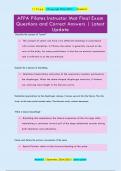Exam (elaborations)
AFPA Pilates Instructor Mat Final Exam Questions and Correct Answers | Latest Update
Describe the concept of "center" The concept of center can have very different meanings in accordance with various disciplines. In Pilates, the center is generally viewed as the core of the body, for some practitioners it also has an esoteric connotation and is referred to as the powerho...
[Show more]



